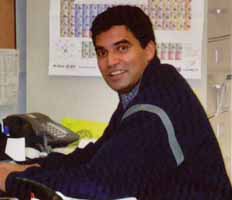Dr. David H. Gracias
The article Tiny self-assembling cubes could carry medicine, cell therapy said
“Johns Hopkins researchers have devised a self-assembling cube-shaped perforated container, no larger than a dust speck, that could serve as a delivery system for medications and cell therapy.The relatively inexpensive microcontainers can be mass-produced through a process that mixes electronic chip-making techniques with basic chemistry. Because of their metallic nature, the cubic container’s location in the body could easily be tracked by magnetic resonance imaging.
‘Our group has developed a new process for fabricating three-dimensional micropatterned containers for cell encapsulation and drug delivery’, said David H. Gracias, who led the lab team. ‘We are talking about an entirely new encapsulation and delivery device that could lead to a new generation of ‘smart pills’. The long-term goal is to be able to implant a collection of these therapeutic containers directly at the site or an injury or an illness.’”
Dr. David H. Gracias was born in 1972 in Bombay, India. He completed his undergraduate studies at The Indian Institute of Technology (IIT), Kharagpur where he completed a 5 year Integrated M.S. in 1994. He moved to the US for graduate studies in 1994 where he received his Ph.D. in Physical Chemistry from the University of California at Berkeley and the Materials Science Division of Lawrence Berkeley National Laboratory.
After completing his Ph.D., David was a post-doctoral fellow at Harvard where he demonstrated biomimetic strategies for forming functional electronic devices using surface modification and self-assembly. Subsequently he was employed as a Senior Engineer in Research and Development at Intel Corporation, where he was responsible for integrating new processes for fabricating logic (digital) processors and mixed signal (analog + digital) communication chips at the 45nm-90nm nodes.
He joined the Department of Chemical and Biomolecular Engineering at Johns Hopkins University in August 2003. His research interests lie in the areas of Micro and Nanotechnology, Self-assembly, Non-Linear Optics, Nanoelectronics, Interfacial Science, Biomedical Devices and Nano-Medicine.
David has published 25 research papers, holds 6 US patents (over 10 patents pending) and has given 20 invited talks in the research areas listed above. His patents include “Adhesion of carbon doped oxides by silane coupling agents in damascene integration of microelectronic devices”, “Reducing line to line capacitance using oriented dielectric films”, “Protecting metal conductors with sacrificial organic monolayers”, and “Method to increase electromigration resistance of copper using self assembled organic thiolate monolayers”.
In 2005, he received the National Science Foundation (NSF) CAREER award — the foundation’s most prestigious award for new faculty members. The award recognizes and supports the early career development activities of those teacher-scholars who are most likely to become the academic leaders of the 21st century.
Lifeboat Tidbit: Gracias has the connotation of “gracious” in Portuguese. Many people are curious how a person from India might be named David Gracias. David’s lineage is from Goa, a region on the west coast of present day India bordering the Arabian Sea. Goa was the capital of the Portuguese empire in the East from 1510 to 1961. Since 1961 Goa has become a part of India.
